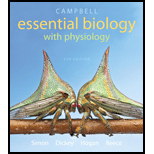
Concept explainers
Introduction: The animals divided by the sagittal plane into two equal parts are called bilateral symmetrical animals. The plane divides the body into two equal halves, but the inner organs need not be symmetric in the bilaterally symmetrical animals.
Answer to Problem 1SQ
Correct answer: Bilateral symmetry in the animal kingdom is best correlated with motility and active predation and escape. Therefore, option c. is correct.
Explanation of Solution
Reason for the correct statement:
The bilateral symmetrical animals do have a distinct head end, which is the association of nerve ganglia, mouth, and the sensory organs. This formed head end help in the development of the organ called the brain.
The collective working of the head end and the brain lead to the quick responses to the external stimuli, such as threat, food, and others. This benefits the bilateral animals in locomotion, including swimming, walking, crawling, and jumping. The bilateral animals learn to predate other animals by using these movements.
Option c. is given as “motility and active predation and escape”.
As, “the bilateral symmetry help the animals in locomotion. The animals can easily predate others by locomotion activities, and can also escape when they are in danger” it is the right answer.
Hence, option c. is correct.
Reasons for the incorrect statements:
Option a. is given as “ability to sense equally in all directions”.
The bilateral symmetrical animals can sense more efficiently in the moving direction as compared to other directions. So, it is a wrong answer.
Option b. is given as “the presence of a skeleton”.
The
Option d. is given as “development of a body cavity”.
The body cavity is the space that divides the body wall from the digestive tract of an animal. The body cavity does not relate to the bilateral symmetry because the bilateral symmetry defines the two equal halves of the outer body.
Hence, options a., b., and d. are incorrect.
The bilateral symmetrical animals are motile, active predators, and can easily escape from the danger.
Want to see more full solutions like this?
Chapter 17 Solutions
Campbell Essential Biology with Physiology (5th Edition)
- Molecular Biology Question Please help. Thank you Explain what is meant by the term “defective virus.” Explain how a defective virus is able to replicate.arrow_forwardMolecular Biology Explain why changing the codon GGG to GGA should not be harmful. Please help . Thank youarrow_forwardStage Percent Time in Hours Interphase .60 14.4 Prophase .20 4.8 Metaphase .10 2.4 Anaphase .06 1.44 Telophase .03 .72 Cytukinesis .01 .24 Can you summarize the results in the chart and explain which phases are faster and why the slower ones are slow?arrow_forward
- Can you circle a cell in the different stages of mitosis? 1.prophase 2.metaphase 3.anaphase 4.telophase 5.cytokinesisarrow_forwardWhich microbe does not live part of its lifecycle outside humans? A. Toxoplasma gondii B. Cytomegalovirus C. Francisella tularensis D. Plasmodium falciparum explain your answer thoroughly.arrow_forwardSelect all of the following that the ablation (knockout) or ectopoic expression (gain of function) of Hox can contribute to. Another set of wings in the fruit fly, duplication of fingernails, ectopic ears in mice, excess feathers in duck/quail chimeras, and homeosis of segment 2 to jaw in Hox2a mutantsarrow_forward
- Select all of the following that changes in the MC1R gene can lead to: Changes in spots/stripes in lizards, changes in coat coloration in mice, ectopic ear formation in Siberian hamsters, and red hair in humansarrow_forwardPleiotropic genes are genes that (blank) Cause a swapping of organs/structures, are the result of duplicated sets of chromosomes, never produce protein products, and have more than one purpose/functionarrow_forwardA loss of function mutation in Pitx1 enhancers can cause (blank) Removal of Pitx1 exons and growth of ectopic hindlimbs, growth of extra ectopic forelimbs, loss of forelimb specification and development, and loss of hindlimb specification and developmentarrow_forward
- Hox1a most likely contributes to (blank) patterning in the developing embryo? Ventral, posterior, limb or anteriorarrow_forwardSelect all of the following that can help establish Hox gene expression boundaries (things that affect Hox and not things that Hox affects). Retinoic acid, anterior/posterior axis, fibroblast growth factors, vagal neural crest, and enhancersarrow_forwardEctopic expression of Hox often results in (blank) phenotypes. (Blank) transformations are characterized by the replacement of one body part/structure with another. Hoxeotic, homealoneotic, joexotic, or homeoticarrow_forward
 Concepts of BiologyBiologyISBN:9781938168116Author:Samantha Fowler, Rebecca Roush, James WisePublisher:OpenStax College
Concepts of BiologyBiologyISBN:9781938168116Author:Samantha Fowler, Rebecca Roush, James WisePublisher:OpenStax College
 Biology: The Dynamic Science (MindTap Course List)BiologyISBN:9781305389892Author:Peter J. Russell, Paul E. Hertz, Beverly McMillanPublisher:Cengage Learning
Biology: The Dynamic Science (MindTap Course List)BiologyISBN:9781305389892Author:Peter J. Russell, Paul E. Hertz, Beverly McMillanPublisher:Cengage Learning Biology 2eBiologyISBN:9781947172517Author:Matthew Douglas, Jung Choi, Mary Ann ClarkPublisher:OpenStax
Biology 2eBiologyISBN:9781947172517Author:Matthew Douglas, Jung Choi, Mary Ann ClarkPublisher:OpenStax Biology (MindTap Course List)BiologyISBN:9781337392938Author:Eldra Solomon, Charles Martin, Diana W. Martin, Linda R. BergPublisher:Cengage Learning
Biology (MindTap Course List)BiologyISBN:9781337392938Author:Eldra Solomon, Charles Martin, Diana W. Martin, Linda R. BergPublisher:Cengage Learning





